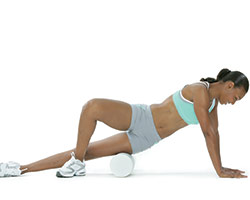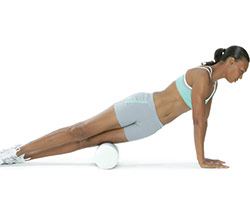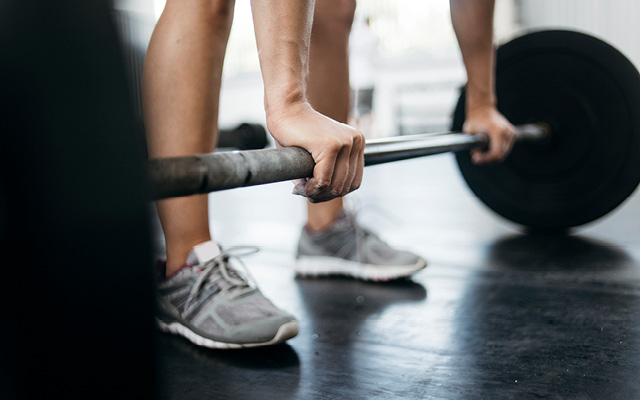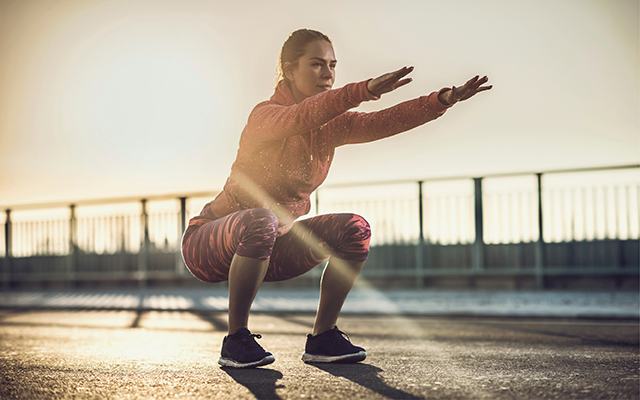Should I try Olympic lifts?
Q1: I see people around my gym doing Olympic lifts (power cleans and overhead snatches). They look like fun, and I hear they’re great exercises. What do I need to know to try them?
A: Nothing says “I feel strong!” quite like hefting a barbell overhead and holding it motionless for a second or two. It looks pretty cool, too.
All Olympic-style lifts are variations on the two weightlifting movements featured in the Olympic Games: the “snatch,” in which you pull a barbell from the floor to an overhead position in one explosive movement; and the “clean and jerk,” where you hoist the bar to shoulder level, then push it overhead (see “Learn to Power Clean” for details on proper form).
Both lifts require — and build — lots of power. Most people begin to lose muscle mass around age 30, starting with the white, fast-twitch muscle fibers — the largest, most powerful fibers in your body. The best way to work these fibers, and stave off age-related muscle loss, is with exercises that require you to move either as quickly or forcefully as possible. “Heavy Olympic lifts require you to do both,” says Olympic weightlifter Wil Fleming, CSCS.
Practice these moves often enough, continues Fleming, and your increased strength will also help you jump higher, run faster, and throw farther in your favorite sports. Another benefit? Because “O-lifts” engage nearly every muscle in the body, you’ll burn fat at the same time.
One important caveat: Olympic lifting requires not just full-body strength but also mobility, coordination, timing, and balance. So for those interested in working up to challenging weights, Fleming recommends seeking out qualified instruction. “I’ve been practicing these lifts for 15 years,” Fleming explains, “and I still work on my technique, the same way a golfer might work on his swing.” To locate a club, visit USAWeightlifting.org or seek out a trainer certified as a Performance Enhancement Specialist by the National Academy of Sports Medicine.
How often should I replace my workout shoes?
Q2: How often should I replace my workout shoes?
A: It really depends on your body size, activities of choice, and preferred shoe type, says Jamie Mieras, DPM, a doctor of podiatric medicine and distance runner from Boulder, Colo. Though as a general rule of thumb, she adds, you should replace your workout footwear “at least every six months, or every three to four months if you wear them four or more times per week.” For serious runners, that usually equates to replacing your shoes after 400 to 500 miles of use.
Larger people should replace their shoes more frequently, says Mieras, as should people who sprint frequently or do high-impact cross-training. And depending on the materials, lighter shoes may wear down faster.
Bearing all that in mind, pay attention also to how your shoes feel when you put them on, regardless of how long you’ve had them. “When your shoes start feeling ‘flat,’ or when they lose that ‘makes-you-fly’ feeling,” says Mieras, “it’s time for a new pair.”
To prolong the life of your shoes, Mieras recommends keeping multiple pairs in your closet, each for a different terrain or activity (trail, road, gym). Don’t take walks in your running shoes or lift weights in your trail-runners. Switching shoes this way — and retiring older shoes once they’ve lost their mojo — will also help guard against overuse injury.
What’s the best way to (finally) quit smoking?
Q3: My New Year’s resolution is to quit smoking. I’ve tried numerous times but always relapse. Do you have any advice on setting myself up for success this time around?
A: Nicotine addiction can be tough to beat: More than 85 percent of people who report having quit smoking relapse within a month, a Journal of the National Cancer Institute study found. There’s reason to be optimistic, though: The same study found that more than half of the former smokers who stayed off cigarettes for three months went on to abstain in the long-term. So make it an initial goal to give it up for just three months.
And don’t try to go it alone, advises Richard A. Brown, PhD, psychiatry and human behavior professor at Brown University. “Getting some form of counseling in combination with some form of pharmacotherapy for quitting smoking more than doubles your chances of success,” he says. One-on-one therapists, support groups, and over-the-phone counseling (available free in all 50 states) are all effective options. Nicotine patches and smoking-cessation medications, available by prescription, can help, too.
Regular exercise may also play a role in overcoming addiction, preliminary research suggests. Why that is remains unclear: “It’s possible that exercise induces biochemical changes in a person’s brain,” Brown says. “Or that replacing a detrimental habit with a positive one gives you new confidence” in your efforts to quit. Studies on mice have further indicted that exercise may prime the brain to adapt to a drug-free life after a controlled substance is removed.
Whatever the reason, it won’t hurt you to hit the gym while you’re weaning yourself off nicotine.
Fitness Fix: Foam Rolling
Think of it as the world’s least-expensive, most-reliable massage therapist. The foam roller — a 3-foot-long, 6-inch-diameter cylinder of hard, industrial Styrofoam — is a rolling pin for your muscles: Place it on the floor, position your body on top of it, and roll out your tight muscles like you’re rolling out bread dough.
For such a low-tech device, foam rollers can be remarkably effective: Rolling the hamstring muscles can substantially improve flexibility after just five seconds without adversely affecting strength or performance, a 2013 study in the International Journal of Sports Physical Therapy found.
Serious exercisers should spend five to 10 minutes rolling out major muscle groups before each workout, says Mike Robertson, MS, CSCS. Key areas include the fronts, insides, and outsides of each thigh; the calves, hamstrings, and glutes; and the front, sides, and back of your upper torso (make adjustments if you’re female). Take a full 10 to 20 seconds rolling out the entire length of each muscle group, spending more time on areas that feel exceptionally tight.
Foam rolling can have the same “hurts so good” feeling you get during an intense massage — particularly the first few times out. So breathe deeply and relax as much as possible. As you loosen up, the discomfort will lessen.
IT Band Roll
The iliotibial band is a straplike length of connective tissue that runs along the outside of your thigh from your hip to your shin. It can get very tight. Release yours — and guard against knee pain and injury — with this simple one-minute drill.


- Place the roller on the floor.
- Lie on it on your left side, perpendicular to the roller, with the outside of your left thigh resting on the roller.
- Place your right foot flat on the floor in front of your left knee and place your hands comfortably on the floor in front of you, supporting your upper body.
- Bracing yourself with your hands, slowly roll the outside of your left thigh along the roller, all the way down to the outside of your knee, taking 20 to 30 seconds to get there. Spend a few extra seconds on any areas that feel tender.
- Repeat the movement on the other thigh.




This Post Has 0 Comments